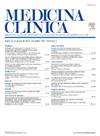2019冠状病毒病3年后的症状和生活质量:西班牙一家三级医院C19-YRS调查结果的演变
IF 2.1
4区 医学
Q1 MEDICINE, GENERAL & INTERNAL
引用次数: 0
摘要
covid后综合征会影响患者的生活质量。本研究旨在描述该综合征及其自然病史。方法前瞻性研究纳入443例2020年3月至5月期间获得的COVID-19住院和门诊幸存者。痴呆患者、养老院居民和拒绝参与的人被排除在外。在感染后10个月和36个月使用C19-YRS问卷评估症状。调查了症状的患病率和严重程度,以及症状持续的危险因素。结果10个月时62.3%的患者报告至少一种症状,36个月时下降到54.9%。疲劳(37.2%)、用力时呼吸困难(33.4%)和焦虑(33.4%)是最常见的症状,这些症状在随访时均有所改善。领域特异性损伤是症状持续的最大危险因素。与感染前相比,大多数患者报告的健康状况(69.4%)和生活质量(71.4%)相似。结论虽然频繁,但随着时间的推移,covid -19后症状会改善,而与患者基线状态相比,生活质量保持稳定。本文章由计算机程序翻译,如有差异,请以英文原文为准。
Presencia de síntomas y calidad de vida 3 años tras el COVID-19: evolución de los resultados de la encuesta C19-YRS en un hospital terciario español
Introduction
Post-COVID syndrome can hinder the quality of life of patients. This study aims at describing this syndrome and its natural history.
Methods
Prospective study including 443 inpatient and outpatient survivors of COVID-19 acquired between March and May 2020. Patients with dementia, nursing home residents, and those rejecting participation were excluded. Symptoms were assessed 10 and 36 months after the infection using the C19-YRS questionnaire. The prevalence and severity of symptoms, as well as risk factors for symptom persistence were investigated.
Results
At 10 months 62.3% of patients reported at least one symptom, down to 54.9% at 36 months. Fatigue (37.2%), dyspnea at exertion (33.4%), and anxiety (33.4%) were the most prevalent symptoms, all of which showed improvement at follow up. Domain-specific impairment was the strongest risk factor for symptom persistence. Most patients reported a similar health status (69.4%) and quality of life (71.4%) compared with their pre-infection condition.
Conclusions
Although frequent, post-COVID-19 symptoms improve over time, while quality of life remains stable compared to patients baseline status.
求助全文
通过发布文献求助,成功后即可免费获取论文全文。
去求助
来源期刊

Medicina Clinica
医学-医学:内科
CiteScore
3.10
自引率
5.10%
发文量
295
审稿时长
22 days
期刊介绍:
Medicina Clínica, fundada en 1943, es una publicación quincenal dedicada a la promoción de la investigación y de la práctica clínica entre los especialistas de la medicina interna, así como otras especialidades. Son características fundamentales de esta publicación el rigor científico y metodológico de sus artículos, la actualidad de los temas y, sobre todo, su sentido práctico, buscando siempre que la información sea de la mayor utilidad en la práctica clínica.
 求助内容:
求助内容: 应助结果提醒方式:
应助结果提醒方式:


